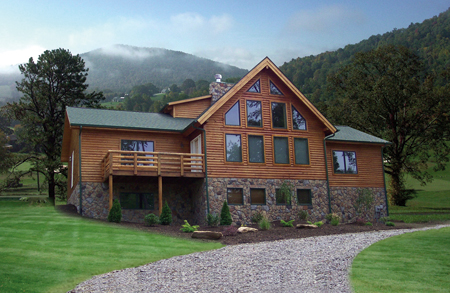You’ve dreamed of owning a log home, and now you’re ready to start putting plans on paper. The first step in making your dream come true is to find the right piece of land. Are you looking for a cozy retreat in the mountains or a getaway at the lake? Do you want a remote location, or quick access to grocery stores, restaurants, and medical care? Whatever your needs, there are a few factors to consider as you begin to design and develop a “green” building site.
Site Selection
1. Is there a view? Do you want a view of the water or of the mountains? Do you want to be close to nature, with a home nestled in the woods, or do you prefer distant, breathtaking views of mountains and lakes?
2. What are your green goals? If you want to use solar energy, an open site with few trees obviously will work better than a woodsy spot, says Michelle Kruzel, an architect with Town & Country Cedar Homes in Petoskey, Michigan. Homeowners wanting to use wind power should find a site with few obstructions. Also, avoid sensitive areas, such as wetlands, sites of historical importance, or those with highly erodible soil.
3. Consider the slope. A flat lot typically is the easiest and least expensive to build on, and an open area will require less tree removal. Matt Franklin, lead architect for Mountain Architects and PrecisionCraft Log and Timber Homes of Meridian, Idaho, suggests picking a site that will easily accommodate the home you have designed—or, if you select your land first, design a home that complements the land’s natural features. Doing so will minimize the need for excess digging or bringing in fill-dirt. “You want to pick a site that the home you need can nestle into and work with the typography,” Franklin says.
4. Access to amenities. Check into the availability of water, septic/sewer and electricity, cable, etc. at your location. These services may be readily available in a subdivision, but if you’ve selected a remote location, you may incur additional costs to bring them to your site. Additionally, think about the site’s proximity to medical care, shopping, entertainment, hiking, or bike trails—any amenity that’s important for your personal needs and preferences.
Orientation and Placement
1. Where’s the sun? Many log homes are situated in beautiful, natural settings and often incorporate large expanses of glass that showcase the scenic views. Unless you live in a very cold climate, Franklin recommends not facing the glass directly south, west or southwest, which could cause significant thermal gain throughout the day. If you can’t avoid those directions because of a particular view, incorporate large overhangs or covered decks to shade the house as much as possible. Also, consider installing high-quality, low-emission, and double- or triple-paned glass to protect your home from the sun’s UV rays.
2. Comfortable entrance. For snowy regions, avoid orienting a front entrance or garage entrance to the north. “If you can have the entrance and garage doors facing south, southwest or southeast, that sun will help melt the snow and ice for you and make the entrance to your home more enjoyable and usable than it would otherwise,” Franklin explains.
Erosion Control
1. Tread lightly. By preserving the existing landscape and natural grade as much as possible during construction, you’ll minimize the need for additional erosion control measures during and after construction.
2. Build trenches. Incorporating stone trenches around the perimeter of your house will keep the soil from eroding and prevent dirt from splashing on the sides of the house.
3. Save the trees. Trees and other vegetation are important for holding top soil in place, says Allen Halcomb, president of MossCreek Designs in Knoxville, Tennessee. Their strong root systems soak up the excess water to help prevent flooding and soil erosion. Instead of cutting down trees, Chad Cassio, owner of Ashton Hawk Design and Development, suggests “raising their canopy” by trimming lower branches. Additionally, plant native plants and shrubs to help stabilize sloping ground.
Water Runoff
1. Divert the water. Water runoff is a problem anywhere there’s a hard surface on the property, such as the house, the driveway, or sidewalks. “Capture that water and take it to a safe place,” Halcomb says. Create a water feature on your property, such as a pond or a creek, to collect the water. Avoid diverting water runoff directly into a natural water source, such as a lake, stream, or mountain spring—that could disturb the delicate ecosystem by dispersing unwanted chemicals.
2. Build a “living wall.” Cassio suggests creating a living wall effect by incorporating outcropping stones and plants to slow and filter chemicals out of the water. “It will control the water better than a typical retaining wall and it will actually manage the water in a more productive manner,” Cassio says.
3. Plant a green buffer. Harvest an untreated green strip between lakes or streams on your property. Plants in this buffer area will absorb any of the excess nitrogen or other chemicals used to treat your lawn before the water empties into natural bodies of water.


.jpg)